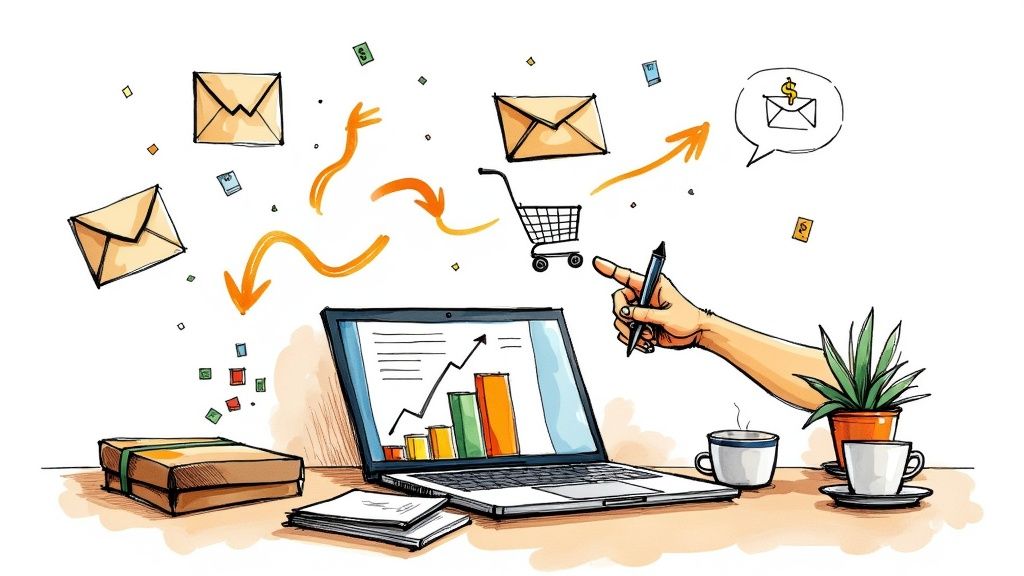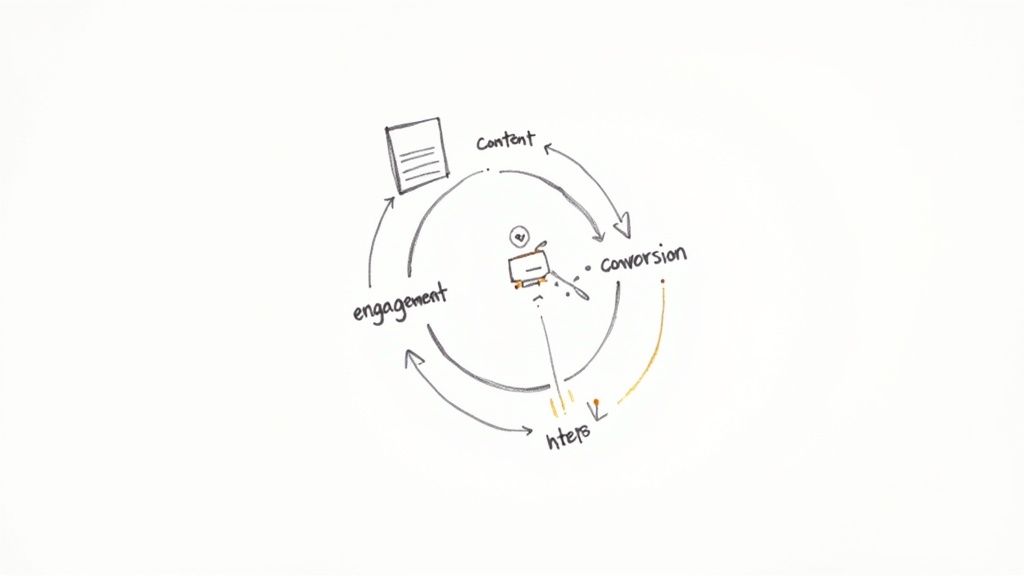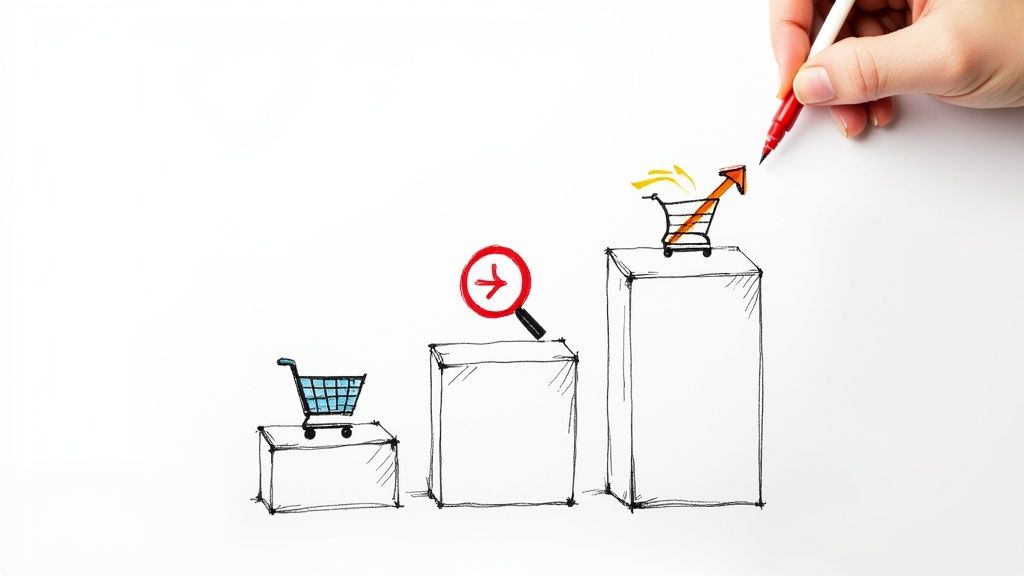Top Strategies to Reduce Shopping Cart Abandonment in 2025
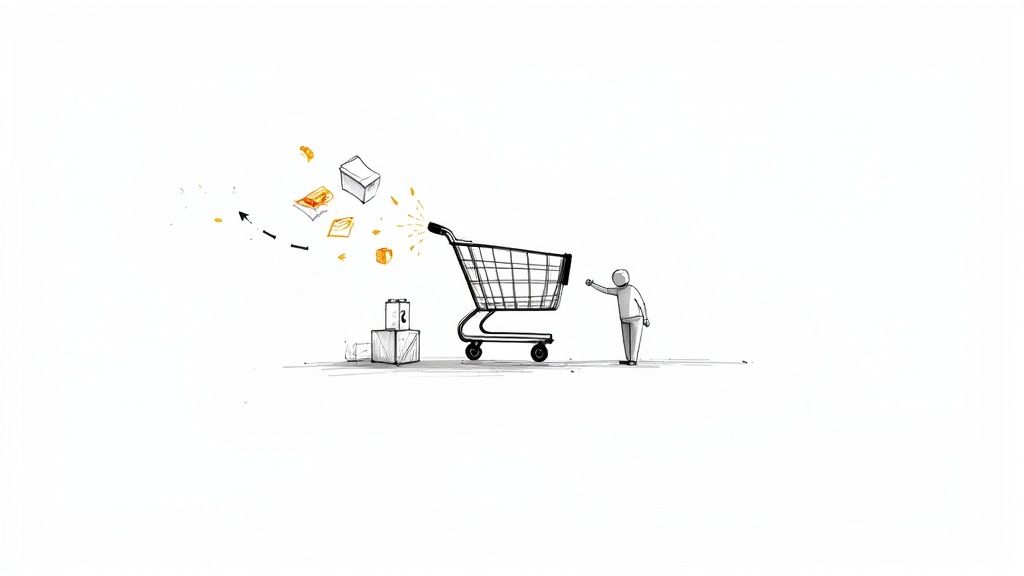
15 mins
5/31/2025
Joe Ervin
- reduce shopping cart abandonment
- cart abandonment
- ecommerce
- online sales
- customer retention
Stop Lost Sales
Is your online store losing money? Many stores lose up to 70% of sales because shoppers leave full carts. This hurts your bottom line. Learn seven simple ways to reduce shopping cart abandonment and boost sales. These tips work for any online store, whether you sell skincare, clothes, or other products. This list covers email, popups, fast checkouts, ads, chat support, trust signals, and clear pricing.
1. Email Remarketing Sequences
Abandoned shopping carts hurt sales. Email remarketing sequences help you win back lost customers. These automated emails remind shoppers about items they left behind. They often offer a little extra push to finish the purchase. Think of it like a friendly reminder, and sometimes a helpful discount. This makes email remarketing a key tool to reduce shopping cart abandonment.
Email remarketing works by tracking customer behavior. When someone adds items to their cart and leaves without buying, the system automatically sends a series of emails. Usually, this is 2-4 emails spread over a few days. These emails show the abandoned items, include details, and may offer discounts to encourage the customer to return and complete their purchase. Features like personalized product recommendations and one-click return to cart buttons make it easy for customers to buy.
For example, Amazon sends a series of emails after you leave something in your cart. ASOS sends stylish reminders with fashion tips. Wayfair might show you how the furniture you picked would look in your room. Learn more about Email Remarketing Sequences.
This approach offers big rewards. Businesses see an average of 20-30% conversion rates. Once you set it up, it runs on its own. You can even personalize the emails for lots of people at once. Email is a low-cost way to market.
There are a few downsides. Too many emails can annoy customers. You need the customer's email address before they leave. Discounts can train customers to wait for a sale.
Email remarketing makes sense if you want to boost sales and recover lost revenue. It's great for e-commerce stores of all sizes. It works well for skincare, clothing, and other product types. The setup is easy, and the payoff can be huge.
Here are some tips for success:
- Send the first email fast (1-3 hours after abandonment). This keeps the items fresh in the customer's mind.
- Use catchy subject lines. "You forgot something!" or "Still thinking about it?" work well.
- Show clear product images. Customers want to see what they're buying.
- Test different discounts. Find the sweet spot for your business.
- Group emails by cart value and customer type. A big spender gets a different email than a first-time buyer.
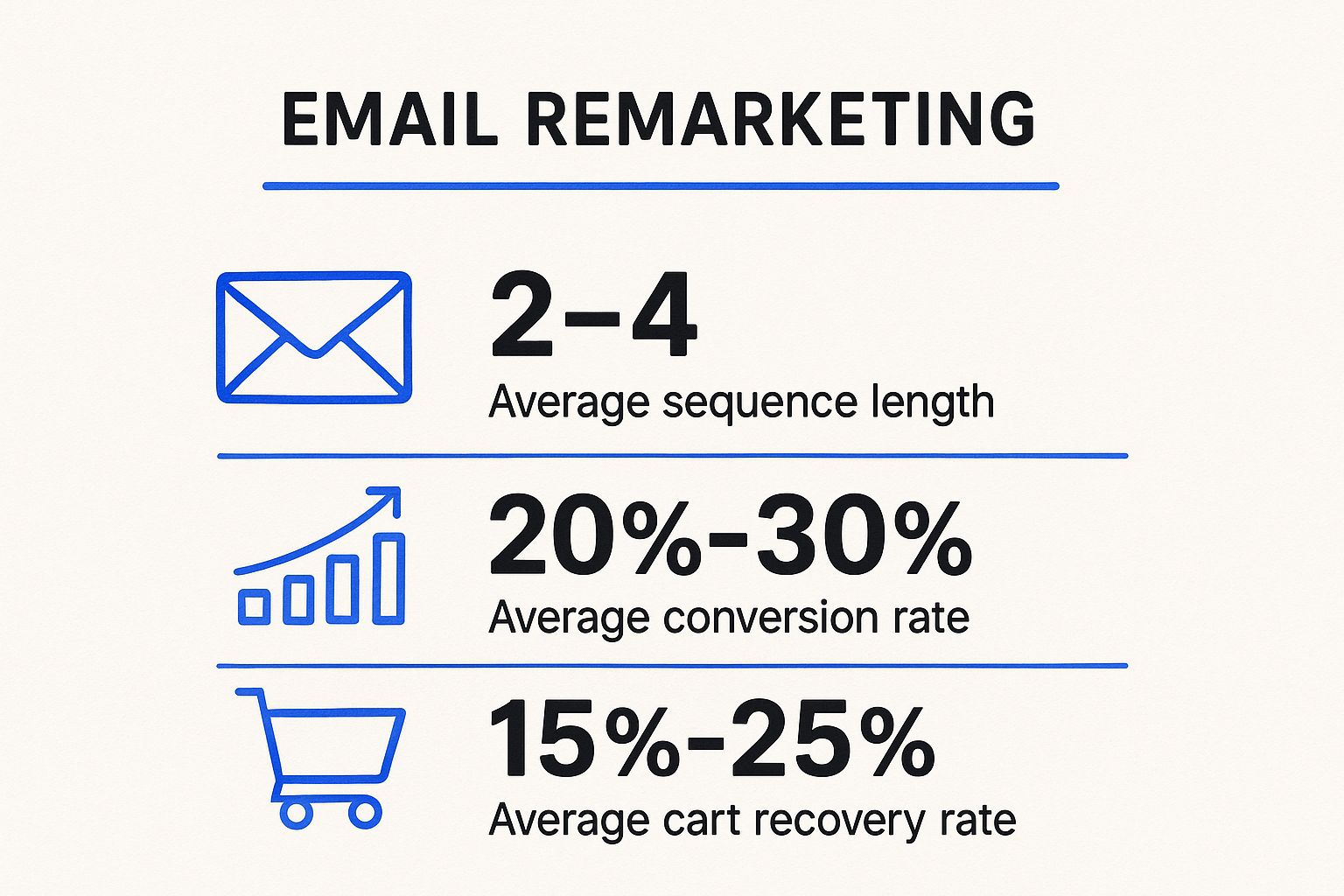
The infographic above shows three important stats about email remarketing: the typical number of emails in a sequence (2-4), the average conversion rate (20-30%), and the average cart recovery rate (15-25%).
These numbers show the power of email remarketing. A 20-30% conversion rate means 20-30 people out of every 100 who abandon their cart will complete their purchase after receiving the email sequence. Recovering 15-25% of abandoned carts adds up to a lot of extra sales.
Popular email marketing platforms like Klaviyo and Mailchimp make it easy to set up these sequences. Amazon was one of the first to use this powerful tool. So, if you're looking for a proven way to reduce shopping cart abandonment and sell more, email remarketing sequences are a must-have.
2. Exit-Intent Popups
Exit-intent popups are like a last-ditch effort to keep shoppers on your site. They use smart technology to track mouse movements. This tech figures out when a shopper is about to leave. Right before they go, a popup appears. This popup tries to convince them to stay. It might offer a discount, ask for their email, or answer their questions. This can help reduce shopping cart abandonment.

These popups are important because many shoppers leave without buying. Maybe they're not ready, or maybe they just got distracted. Exit-intent popups give you one last chance to turn them into customers. They can grab 10-15% of these almost-lost sales. Even if someone doesn't buy right then, you can get their email for later marketing. This lets you build your email list and send them deals and updates. They might buy something next time!
Companies like OptinMonster, Sumo, and Privy make these tools. OptinMonster helped Whole Foods Market increase conversions by 15%. Sumo powers popups for brands like AppSumo. Privy helps Shopify stores recover an average of $2,500 each month in abandoned sales. These examples show how powerful these tools can be for ecommerce businesses, skincare brands, and clothing stores.
Exit-intent popups have many useful features. You can change the design and message. You can test different versions to see which works best (A/B testing). The popups also work well on phones (mobile-responsive). You can even connect them to your email marketing system. This makes it simple to send targeted emails to people who sign up through the popup.
These popups work best when you offer real value. A small discount won't cut it. Think 10-20% or more. Your popup message should be clear and direct. Address common worries shoppers have about price or shipping. Don’t show the popup to returning visitors too often. This can annoy them. Test different designs and offers. Make sure the popup looks good and works well on phones.
While exit-intent popups are effective, they have some downsides. Some shoppers find them annoying. They can be less effective on phones. If you use them too much, they can hurt your website experience. Ad blockers can also stop them from showing up.
Use exit-intent popups if you want a simple way to reduce shopping cart abandonment. They are easy to set up and don't cost much. They offer a strong chance to get lost sales back. They also help build your email list. Just remember to use them wisely. Focus on giving value and don’t overdo it. This ensures a positive experience for your shoppers.
3. Streamlined Checkout Process
A clunky checkout process is a major reason shoppers abandon their carts. A streamlined checkout makes buying easy and fast. It removes roadblocks and gets customers to the finish line quickly. This means more sales for you.
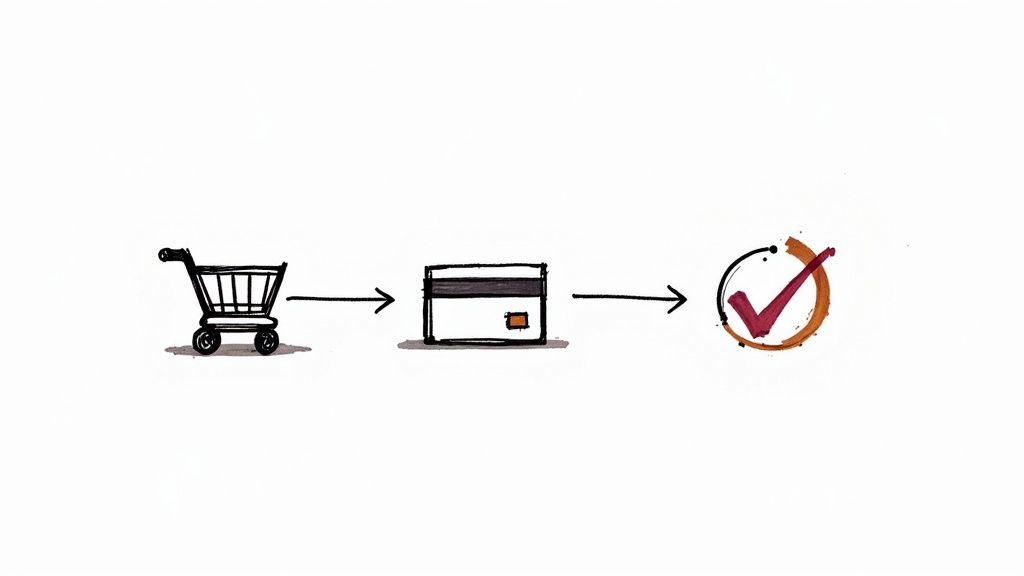
Think of your checkout like a highway. A smooth, clear highway lets cars speed to their destination. A bumpy, confusing highway with lots of exits causes traffic jams. Your checkout should be the smooth highway. Fewer steps and clear directions help customers finish their purchase without getting lost or frustrated.
Features of a streamlined checkout include a single-page design or a minimal number of steps. Offer a guest checkout option so customers don't have to create an account. Show a progress indicator so they know where they are in the process. Use auto-fill and address validation to make filling out forms quick and easy. Finally, offer many payment options.
A streamlined checkout directly tackles a main reason for cart abandonment. It makes shopping easier and more enjoyable for everyone. Studies show it can cut cart abandonment by 20-40%. It helps all customers, not just those you can win back later.
For example, Amazon’s one-click buying is famous for its speed. Apple integrates Apple Pay into its checkout for a seamless experience. Shopify helped stores cut checkout steps from six to three. These companies understand a simple checkout is key to happy customers and more sales.
While a streamlined checkout offers big benefits, there are some challenges. You'll need developers to build and maintain it. You need to find the right balance between a simple checkout and gathering necessary customer data. Testing and tweaking your checkout is an ongoing process.
Here are some simple tips to streamline your checkout:
- Keep it short: Aim for two or three steps max.
- Offer guest checkout: Always let customers buy without creating an account.
- Show trust signals: Display security badges to build confidence.
- Be upfront about costs: Show all costs, including shipping, early on.
- Use a progress indicator: Let customers know where they are in the checkout process.
Why should you use a streamlined checkout?
Simple. It's one of the most effective ways to reduce shopping cart abandonment. It directly improves the customer experience, leading to more completed purchases and higher sales. Whether you sell skincare, clothing, or any other product online, a streamlined checkout is a must-have. It’s a proven method popularized by giants like Amazon, Shopify, and BigCommerce, demonstrating its importance in the world of ecommerce. They know a simple checkout is good for business. You should too.
4. Retargeting Ads
Shopping cart abandonment hurts sales. Retargeting ads help you win back lost customers. These ads follow people who visited your website but didn't buy anything. They remind shoppers about the items they left behind. Think of it like a friendly nudge, saying, "Hey, don't forget this!"
Retargeting ads show up on sites like Facebook, Google, and other places online. They work by using "pixels." These tiny trackers follow visitors after they leave your site. This lets you show them specific ads about the products they viewed. For example, if someone looks at a blue sweater on your site, they might see an ad for that same sweater later on Facebook. This keeps your products top-of-mind and encourages shoppers to return and finish their purchase.
Here’s how it helps reduce shopping cart abandonment: A potential customer adds a face cream to their cart, but gets distracted and leaves. Later, they're scrolling through Instagram and see an ad for that same face cream. This reminder might be all they need to go back and buy it. The same holds true for clothing or any other product.
Retargeting offers several key features:
- Pixel Tracking: Follows site visitors.
- Dynamic Product Ads: Shows the exact items people viewed.
- Cross-Platform Delivery: Reaches people on different websites and apps.
- Audience Segmentation: Targets specific groups based on behavior.
- Automated Bidding: Optimizes ad spending for best results.
Why should you use retargeting ads?
Retargeting ads are super effective. They work better than regular ads because they target people who already showed interest in your products. They see your brand again and again. This helps them remember you and builds trust. This can lead to more sales and happier customers.
Examples of Successful Retargeting:
- A clothing store uses Facebook Dynamic Ads to show abandoned cart items. This helps them recover lost sales.
- A skincare brand retargets previous visitors with Google Shopping ads, highlighting special offers. This attracts customers back to their website.
- Large retailers use Criteo's personalized retargeting to boost sales. This helps them reach customers who are most likely to buy.
Learn more about Retargeting Ads
Pros of Retargeting Ads:
- Wide Reach: Connects with shoppers everywhere they go online.
- High Conversions: Works better than ads targeting new customers.
- Smart Recommendations: Suggests products shoppers might like.
- Trackable Results: Easy to see what's working and what's not.
Cons of Retargeting Ads:
- Cost: Requires an advertising budget.
- Privacy Rules: Limits how you can track customers.
- Annoyance Factor: Can bother people if you show too many ads.
- Platform Dependence: Relies on outside services like Facebook and Google.
Tips for Effective Retargeting:
- Limit Ad Frequency: Don't overwhelm shoppers. Show ads a few times, not dozens of times.
- Use Great Images: Catch attention with eye-catching visuals. Show happy customers using your products.
- Test Different Ads: Try various formats and placements to find what works best.
- Exclude Recent Buyers: Don't show ads to people who already bought something.
- Create Urgency: Offer limited-time deals to encourage quick purchases.
Popular Platforms for Retargeting:
- Facebook Ads Manager
- Google Ads
- Criteo
- AdRoll
Retargeting deserves a spot on this list because it's a proven way to reduce shopping cart abandonment. It’s a powerful tool for ecommerce brands, skincare brands, and clothing brands. By reminding shoppers about the items they left behind, you can recapture lost sales and grow your business. Use these tips to create retargeting campaigns that are both effective and respectful of your customers' privacy.
5. Live Chat and Customer Support
Lost customers mean lost sales. Live chat and customer support help you keep those sales. These tools give shoppers quick help when they need it. This stops them from leaving their cart behind. Think of it as having a helpful store clerk ready to answer questions at any time.
Live chat pops up on your website. It lets shoppers message you directly. Chatbots use computer programs to answer simple questions instantly. This works even if your team isn't online. Some tools can even guess when a shopper needs help and offer it before they ask. For tricky questions, a real person can take over. Features like screen sharing let you see what the shopper sees, making it easier to solve problems. This all creates a better shopping experience.
Zappos is famous for its great customer service. Their phone support helps lower abandoned carts. Sephora’s chatbot helps shoppers find the right makeup and finish their purchase. Intercom’s targeted messages help software companies sell more.
Here's why live chat and customer support earn a spot on this list:
- Addresses concerns quickly: Shoppers get answers right away. No waiting for emails. This keeps them moving toward checkout.
- Builds trust: Helpful support shows shoppers you care. They feel confident buying from you.
- Gives personal advice: Suggest products shoppers might like. This can lead to bigger sales.
- Makes shopping better: A smooth, easy experience keeps shoppers happy. Happy shoppers become loyal customers.
Live chat has some drawbacks, too. You need staff to answer chats. Good chatbot software can be pricey. Complex problems frustrate shoppers if a chatbot can’t help. Covering different time zones can be tough.
Learn more about Live Chat and Customer Support
Tips for success:
- Offer help on important pages: Show live chat on pages with expensive items or where people often abandon their carts.
- Train your team: Teach your team how to handle common questions and complaints.
- Use bots for easy questions: Chatbots are great for simple things like "Where's my order?" Use real people for tough problems.
- Offer help everywhere: Let shoppers contact you on their favorite channels, like chat, email, and social media.
- Track your results: See how many chats lead to sales. This helps you know what works.
When to use live chat and customer support:
- High-value products: If you sell pricey items, live chat can help justify the cost. Shoppers often have more questions about big purchases.
- Complex products: If your products need explanation, live chat helps shoppers understand. Think skincare routines or custom clothing.
- Lots of abandoned carts: If many shoppers leave without buying, live chat can help you find out why and fix the problem.
Examples for different businesses:
- Skincare: A chatbot can help shoppers find the right products for their skin type. Live chat can answer questions about ingredients or offer personalized advice.
- Clothing: Live chat can help shoppers with sizing or styling tips. A chatbot can answer questions about shipping and returns.
- Ecommerce (general): Use chatbots for order tracking and FAQs. Live chat can help with technical issues or complex orders.
Live chat and customer support are powerful tools. They help you connect with shoppers, build trust, and make more sales. By giving shoppers the help they need, you can turn abandoned carts into completed purchases. Using the tips and examples above, you can use live chat and customer support to boost your sales and grow your business.
6. Trust Signals and Security Assurance
Abandoned shopping carts hurt sales. One big reason people abandon carts is a lack of trust. They worry about website safety and if the business is legit. Trust signals fix this. They show shoppers your site is safe and you’re a real company. This makes them more likely to buy. Reducing shopping cart abandonment means more sales for you.
Trust signals come in many forms. Think of them like clues that tell shoppers, "This store is safe!" One important signal is an SSL certificate. This encrypts data sent between the shopper's browser and your website. You'll see a padlock icon in the address bar when a site has SSL. This shows shoppers their info is safe. Security badges from companies like Norton or McAfee also boost trust. These badges tell shoppers your site is regularly scanned for malware and other threats.
Customer reviews are powerful trust signals, too. Seeing good reviews from other buyers builds confidence. Think about it: you're more likely to buy something if others had a good experience. Testimonials work similarly. These are short stories from happy customers about their positive experiences.
Clear return and refund policies also matter. Shoppers want to know they can return an item if it's not right. A clear policy shows you stand behind your products and care about customer satisfaction. This makes shoppers feel safer buying from you.
A professional website design is another important trust signal. A clean, well-designed site looks more trustworthy than a messy one. Use high-quality photos and easy-to-read text. Make sure your site is easy to navigate. This shows shoppers you’re professional and care about their experience.
Finally, clear contact information builds trust. Shoppers want to know they can reach you if they have questions or problems. Display your phone number, email address, and physical address (if you have one) prominently. This shows you're a real business and not hiding anything.
Examples of Success:
- Norton/VeriSign security badges have helped many businesses increase checkout completions. Shoppers feel safer knowing the site is secure.
- Integrating Trustpilot reviews can reduce cart abandonment by as much as 15%. Positive reviews encourage more purchases.
- Shopify's built-in SSL certificates improve customer confidence. This simple feature shows shoppers their information is protected.
Tips for You:
- Show security badges clearly on checkout pages. This reassures shoppers at a critical moment.
- Put recent customer reviews near the cart and checkout. Let positive experiences influence buying decisions.
- Explain return policies simply and clearly. Make it easy for shoppers to understand their options.
- Use professional photos and website design. A polished look builds trust.
- Show contact information clearly. Make it easy for shoppers to reach you.
Pros of Using Trust Signals:
- Builds the basic trust needed for online sales.
- Addresses safety worries that cause cart abandonment.
- They are usually inexpensive to put in place.
- Helps the entire customer journey, not just checkout.
Cons of Using Trust Signals:
- It can be hard to measure their direct impact.
- Some signals, like reviews, need ongoing work.
- Fake reviews can hurt you if people find out.
Popularized By:
Companies like VeriSign/Norton, Trustpilot, Better Business Bureau, and McAfee Secure have popularized trust signals and shown their value in reducing shopping cart abandonment. They offer services that help build trust and make shoppers feel safe.
Using trust signals is a smart move for any ecommerce business, especially those selling skincare or clothing. These products often involve personal choices, making trust even more critical. By showing you're a safe and trustworthy business, you'll encourage more shoppers to complete their purchases and boost your sales.
7. Transparent Pricing and Shipping Costs
Surprise! High shipping costs at checkout are a top reason shoppers abandon their carts. No one likes hidden fees. Transparent pricing builds trust and keeps customers happy. This means showing all costs upfront. This includes the product price, taxes, shipping, and any other fees. Clear pricing reduces shopping cart abandonment.
How does it work? Simple. Show customers the total cost before they reach checkout. This eliminates nasty surprises. Customers know exactly what they will pay from the start.
Features of Transparent Pricing:
- Upfront Shipping Calculators: Let customers see shipping costs on the product page. They enter their zip code and see the cost before adding to cart.
- All-Inclusive Price Displays: Show the full price, including taxes and fees, next to the product. Don't hide extra costs.
- Free Shipping Thresholds: Offer free shipping on orders over a certain amount. This encourages larger purchases.
- Tax Calculation Transparency: Clearly show how taxes are calculated.
- No Hidden Fees Policy: State clearly that there are no hidden fees. Be upfront and honest.
Benefits of Transparent Pricing:
- Fewer Abandoned Carts: Eliminating surprise costs means fewer people leave at checkout.
- Happy Customers: Transparency builds trust and makes customers feel valued.
- Fewer Questions: Clear pricing reduces customer service inquiries about costs.
Examples of Transparent Pricing in Action:
- Amazon Prime: Customers pay an annual fee for free, fast shipping. They know their shipping costs upfront. This encourages more purchases.
- Warby Parker: They are known for their clear pricing. No hidden fees. What you see is what you pay.
- Everlane: They practice "radical transparency." They share information about their costs and markup. This builds trust with their customers.
Tips for Implementing Transparent Pricing:
- Show Shipping Costs Early: Display shipping costs on product pages. Don't wait until checkout.
- Offer Free Shipping: Free shipping is a powerful incentive. Offer it above a certain order value to increase sales.
- Use Shipping Calculators: Give accurate shipping estimates. This helps customers budget.
- Show Taxes and Fees: Clearly display all taxes and fees before checkout. Don't hide anything.
- Consider Built-in Shipping: You can include shipping costs in the product price. Then offer "free shipping." This can simplify things for customers.
Pros and Cons of Transparent Pricing:
Pros:
- Reduces abandoned carts.
- Builds customer trust.
- Improves customer satisfaction.
- Reduces support inquiries.
Cons:
- Initial prices may appear higher. Seeing the full price upfront can be a shock if a customer is used to seeing lower prices before adding fees.
- Setting up accurate shipping calculations can be complex. It requires development work.
- Offering free shipping can reduce profit margins. You may need to adjust prices to compensate.
Why Transparent Pricing is Important
For ecommerce brands, especially in competitive areas like skincare and clothing, trust is key. Transparent pricing is crucial for building that trust. It shows you value your customers. It also makes the buying process smooth and simple. This leads to more sales and happier customers. In the long run, honesty and transparency are always the best policies. By implementing transparent pricing, you tackle a major cause of shopping cart abandonment directly and foster a positive customer experience.
7 Strategies to Reduce Cart Abandonment Comparison
| Strategy | Implementation Complexity 🔄 | Resource Requirements ⚡ | Expected Outcomes 📊 | Ideal Use Cases 💡 | Key Advantages ⭐ |
|---|---|---|---|---|---|
| Email Remarketing Sequences | Medium: Setup automation & design | Moderate: Email platform & content | High: 20-30% conversion rates, recover 15-25% carts | Cart abandonment recovery, personalized marketing | High ROI, scalable personalization, cost-effective |
| Exit-Intent Popups | Low-Medium: Popup design & triggers | Low: Tech integration & design | Moderate: 2-4% conversion on triggers | Retaining leaving visitors, list building | Captures abandoning visitors, low cost |
| Streamlined Checkout Process | High: Development & optimization | High: Dev resources & testing | High: Reduces abandonment by 20-40% | Improving checkout UX, reducing friction | Improves UX for all customers, directly lowers abandonment |
| Retargeting Ads | Medium: Setup tracking & campaigns | High: Advertising budget | Low-Moderate: 0.7-2.3% ad conversion | Targeting past visitors, multi-channel outreach | Cross-platform reach, measurable ROI |
| Live Chat and Customer Support | Medium-High: Staffing & tech | High: Support staff & software | High: Can increase conversions by 20-40% | Real-time assistance, complex customer queries | Real-time help, builds trust, personalized support |
| Trust Signals & Security Assurance | Low: Adding badges & reviews | Low: Design & maintenance | Moderate: Increases conversions 8-15% | Building trust, enhancing security perception | Builds fundamental trust, low cost |
| Transparent Pricing & Shipping Costs | Medium: Price calculation & display | Medium: Development & policy | High: Reduces abandonment by 25-30% | Eliminating surprise costs at checkout | Builds trust, improves satisfaction, reduces inquiries |
Get More Sales Now
You can reduce shopping cart abandonment. Use these seven tips to get more sales: email remarketing, exit-intent popups, a simple checkout, retargeting ads, live chat support, trust signals, and clear prices and shipping.
These tips work. Fewer abandoned carts mean more money for your skincare, clothing, or other e-commerce brand. Want more sales? Focus on these key areas. They will make a big difference.
What should you do now? Pick one of these tips. Start using it today. Then, try another. Small changes can make a big impact. Reduce shopping cart abandonment now. Watch your sales grow.
Trace can help too. We help online stores make more money from returning customers. If you sell more than $500,000 a year, we can build email flows, campaigns, and content for you in 30 days. Find out more at [Trace website link].
